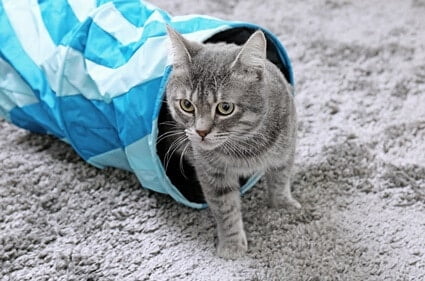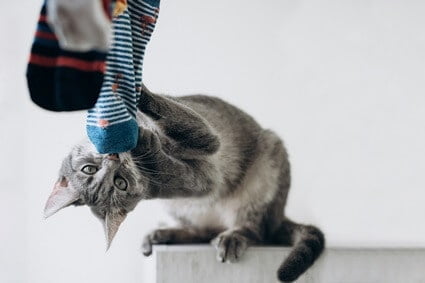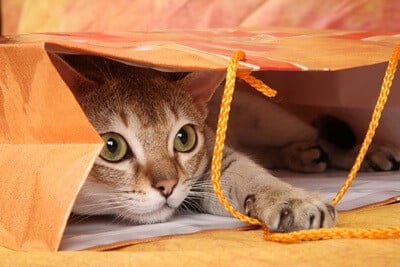Playing with your cat doesn’t always have to mean spending a small fortune on store-bought toys. There are ways to play with a cat that don’t require toys at all. There are even improvised toys that you can put together with items from around the house.
Cat toys can be improvised using wadded-up paper balls and empty plastic drinking bottles. One cat will love hiding in cardboard boxes, while another will adore chasing ping pong balls. You can also play games with your cat, like King of The Castle and Fetch. A cat may also appreciate having its toys rotated in and out. This keeps things fresh and benefits its enrichment. Play is also vital for forming and maintaining pet-owner bonds.
A domestic cat needs an outlet for its energy and instincts. Wild cats express this through hunting and prowling territory. Pet cats do not have this option, and thus it is up to the owner to keep it engaged. Play not only provides these important experiences but prevents boredom and keeps the cat active and healthy. This enrichment prevents destructive behaviors born of boredom from forming too.
Do Cat’s Need Toys?
We love to spoil our cats by buying them everything they need. Top-tier food, the softest beds, the tallest cat towers, and many toys. But, do cats need toys? It’s a fair question to ask, as in the wild cats don’t have air wands or roller circuit toys. This is true, however, these animals have other ways to express energy and remain mentally and physically stimulated.
A wild cat will hunt, patrol territory, and interact with its environment. Domesticated cats don’t have this option or, at least, to the same extent. Indoor cats, need toys to enact this natural behavior. This is called enrichment, and it is a vital item that all cats should be provided with.
Now, ‘toy’ is a broad term. By toy, we mean artificial toys that have been manufactured, such as automatic laser pointers or puzzle toys. When we ask the question of ‘do cats need toys?’, these are the toys we mean. The answer to this question isn’t a simple yes or no either. Cats need exercise and mental stimulation. But, cats are also very individual creatures.
One cat may love all toys. One cat may only love two particular types of toy. One cat may have no interest in toys at all. The answer to the question depends entirely on your cat’s preferences when it comes to play. Your cat may not need toys. Whereas your best friend’s cat may need a whole box full of them.
What this question boils down to is testing different manufactured toys, improvised toys, and playing in different ways. There are many ways to play with your cat that don’t involve toys, too.

Playing with Your Cat
We want our cats to be happy and healthy. Playing with your cat is an important step in achieving that. Even for cats, which are miss-characterized as aloof, antisocial animals.
The domestic cat benefits from regular play sessions. Ideally, 10-30 minute sessions every day. Not only does it create a healthy, socialized individual. It grows and reinforces the bond between you and your cat.
All of this is especially true for owners with only a single cat. Households with more than one cat often see those cats bond and interact with each other daily. That is, if the cats get along, which isn’t always guaranteed.
Mental Stimulation
A bored cat is one that will exhibit destructive behavior. Regular play sessions provide your cat with mental stimulation, giving it an outlet for its energy and instincts. Without this outlet, that energy becomes restless, and so too does the cat.
Animal Welfare describes destructive behavior in cats as any one or more of the following acts:
- Excessive vocalization
- Soiling outside of appropriate places
- Scratching
- Aggressive behavior towards other cats or owners
Bonding
Socialization happens through play. Your cat learns many things from you during play, but it also builds trust and a bond. This is especially important when you bring a new cat into your home. That relationship needs to be built and reinforced. Play is a key way to achieve and maintain that.
Exercise
Play is one of the best ways to ensure that your cat gets exercise. Toys, improvised and not, ignite hunting behavior, which encourages cats to get up and get moving. Regular play sessions help your cat burn energy, feel fulfilled, and maintain a healthy weight.
Senior cats may struggle with the more active means of play, and this will mean adapting how play sessions unfold.
Teaching
Cats learn how to play gently when they are young. Animal Behavior notes that social play is the main form of interaction between siblings. A kitten learns to not bite hard or play with its claws out by play-fighting with its littermates and mother.
As a kitten grows, it also learns appropriate play from its owner. Quite unintentionally, many owners teach their young cats to rough play. This happens when we inadvertently teach it to treat our hands and feet as toys, which are substitute prey items.
Your cat learns how to play from you. Teaching it how to play appropriately (without biting or scratching you) requires providing it with an outlet for rough play and hunting behavior. This is slightly difficult to do without toys; however, improvised toys and consistently encouraging correct behavior will work as well.
It is all about teaching the cat that it can bite, scratch, and wreak mayhem upon its toys and not on you, your family and guests, or your other pets.
Teaching Kittens How to Play Gentle
There are three main steps in teaching kittens how to play gentle:
- Discourage it from biting, scratching, or chewing on you with a gentle but firm ‘no’. This is especially important for your hands and feet. No matter how cute it seems, don’t let it wrestle with you.
- Encourage this kind of play with toys. Remove your hand from its reach if it begins to play rough and offer it a toy instead.
- Ignore or discourage rough play behavior targeted at you. Reinforce this behavior being aimed at toys instead.
Improvised Toys for Cats
To keep a cat more engaged with its toys, improvised or not, try rotating them in and out. This keeps things fresh and prevents boredom. Swap out toys every few days.
Paper Balls
What is Christmas morning without a cat diving into the mountain of balled-up wrapping paper? Cats love the sound that a paper ball makes as it skips over the ground. The erratic movements of a paper ball when it ricochets off walls and furniture ignites a prey response.
Sometimes, an improvised cat toy is genuinely as simple as scrunching up a piece of paper. A cat will eventually gnaw and tear apart the ball with its teeth. Rarely will it eat the paper. Still, if you want to prevent paper confetti from littering your floor be sure to retrieve the ball.
Ribbon on a Stick
Putting together your own ribbon on a stick toy is quite simple, and an easy way to engage a cat in play. Take a stick, even a chopstick or ruler will do, and tie a ribbon to one end. Dangle the free end of the ribbon near the cat to entice it to play. Drag the ribbon along the ground or twist it in the air to encourage more active play.
This improvised toy can also be a feather on a string. It would be best to use craft feathers rather than feathers you find outside. The feathers of wild birds can contain mites and other parasites. Feathers sold at hobby-craft stores are either fake or sanitized, making them the safer option.
This is a good toy for those that are teaching cats appropriate play. It keeps your hands out of reach, yet still allows you to interact with your cat.
Paper Bag
Paper shopping or food delivery bags are a favorite toy of many cats. It is not uncommon to finish putting away the groceries only to find that your cat has curled up in one of the empty bags.
Simply keeping one or two of these bags out is a great toy for your cat. Asides from all of the new smells your cat gets to explore, the bag itself is a mini-playhouse. Cats love pouncing into, batting, and scratching at the toughened paper. Scratching a stick along the sides will trigger a prey response.
Ensure that no food remains or oils have leaked into the bag, as many human foods are toxic to cats!
Cardboard Box
Many cat owners have gone through the pains of buying an expensive cat tower or bed, only for the cat to play in the box it came in instead. Much like a paper shopping bag, a cardboard box offers hours of playtime enrichment. Only, the cardboard box will last a fair bit longer. It may also make more mess if the cat decides to tear into it.
The best thing is, you don’t have to do anything to a cardboard box except empty it. Your cat will take things from there.
Cardboard boxes are full of interesting smells and textures. Cats love chewing, scratching, and playing in them. Cats also love sleeping in them, as cardboard boxes are warm, enclosed spaces that offer security and comfort.
Digital Games
If you have a tablet or iPad, you have an improvised cat toy. There are dozens of apps that stimulate cats with visuals and sound to trigger hunting reflexes. Better yet, most of these apps are free, or have a free version.
It’s best to supervise this play session. You don’t want your tablet to get knocked off the table.
Toilet Paper Rolls
Cats are known for unspooling toilet paper rolls. But, did you know that the card core of an empty roll is a great, makeshift toy?
Save a handful of those rolls for playtime. Your cat will love batting them over the floor and chasing them down as they roll. These rolls occasionally move in unexpected ways, which will keep your cat on its toes.
Empty Plastic Bottles
You’d be surprised by how much entertainment a cat will find out of an empty plastic bottle. Screw the cap on tight and roll it towards them. The hollow sounds and dynamic movements of the bottle will often have the cat scrambling to chase it down.
You can also put uncooked rice or a small amount of water in the bottle to weigh it down slightly. This will also produce different sounds, just make sure the lid is on tight.
Empty plastic drink bottles come in all sizes. Try out a few different ones to see which your cat prefers! Too big bottles, though, may intimidate your cat.
Ping Pong Balls
Ping pong balls are great makeshift toys. They bounce, skip, and ping all around, providing endless entertainment. Pop a few down on the floor and let them roll by your cat. Once it starts batting at the balls they’ll take off like rockets.
You can usually pick up packs of ping pong balls for a cheap price as well.
Games To Play with a Cat Without Toys
Now that you’ve got a whole bunch of improvised toys, check out a few games that you can use them for. Not all cats will like these games. On the other hand, some cats will like them all.
Cats may not be exactly like dogs. A cat does form a bond with its owner, though, and most love to play. You just have to be patient, and throw some creativity in there, and you’ll find what your cat enjoys.
Fetch
Cats can, and will, play fetch. It is entirely possible that your cat will naturally return a toy to you once you throw it. If it doesn’t, you can easily teach it how to play.
Improvise a toy that is small and light enough for the cat to carry in its mouth. A paper ball is ideal. Also, grab a handful of treats. Kibble is fine, and won’t risk your cat becoming overweight if many sessions are needed.
In a quiet place free of distractions, entice your cat close by showing it the treat. Once it is near, toss the paper ball and say the word ‘fetch’. If it chases the ball, wait for it to pick it up before calling it back. Offer the treat if further encouragement is needed.
Once your cat returns, give it a treat with verbal praise. Toss the ball again and repeat the process. Gradually increase the distance you throw the ball. Eventually, your cat will come to understand what the command means. At this point, you’ll be able to phase out treats.
This process is all about repetition and positive reinforcement. It may take a few sessions to see consistent results. Keep at it.
This game is a great way to play with your cat. It offers lots of exercise, stimulation, and bonding.

Shadow and Light Play
We’ve all seen the videos of cats chasing laser pointers. Did you know that you can do the same with a simple torch, too?
Use a torch with a narrow beam. Shine the light on the floor or wall. Quick, jerky movements will quickly grab your cat’s attention.
Alternatively, you can use a torch with a broader beam and create shadow puppets. Focus the light on the wall or floor. Hold your fingers before the light so that you have a sharply defined shadow. Wave and wiggle them around. If your cat is interested, it will leap up and try to catch your shadows.
Treat Hunt
This isn’t so much of a game that you play with your cat, as it is offering great enrichment for it.
Take a few morsels of kibble and hide them around a room. Examples are under an overturned plastic cup, on top of a book, or tucked inside an empty toilet paper roll. Your cat will smell these treats and begin hunting them down – much like a wild cat would do when hunting prey.
This can be good for keeping a cat occupied while you are at work during the day.
Puzzle Box
Take a small box. An empty margarine tub or small gift box is ideal. Now, cut holes into it just big enough for kibble to fall through. Drop a small handful of treats inside and secure it shut. Twine is good.
Now, rattle it and set it before your cat. Once it smells the food inside, it will start trying to figure out how to get it. It will sit there for a long time working out how to get at the food. This puzzle box is fantastic for mental enrichment, and great for keeping a cat occupied in a way that doesn’t require supervision.
King of The Castle
This is a great activity for the kids, as well as providing lots of enrichment for your cat. Take one or more cardboard boxes and cut a series of holes. Either make the holes big enough for the cat to fit through, or just big enough for them to poke their paw through. Now make a castle!
Stack the boxes on top of and beside each other, line up the bigger holes, and break out the sticky tape. Once the cat has wandered inside, drag a ribbon or roll a ball near one of the holes and watch a lightning-fast paw shoot out to grab it.
Cats love these structures, and will happily spend hours inside of them. Swap the boxes around for a different setup if they get bored.
Many of the improvised toys and games are great ways to engage your cat. Playtime doesn’t have to mean pressing a button on an automatic laser pointer. It can mean wonderful bonding sessions between you and your cat, all without toys.

